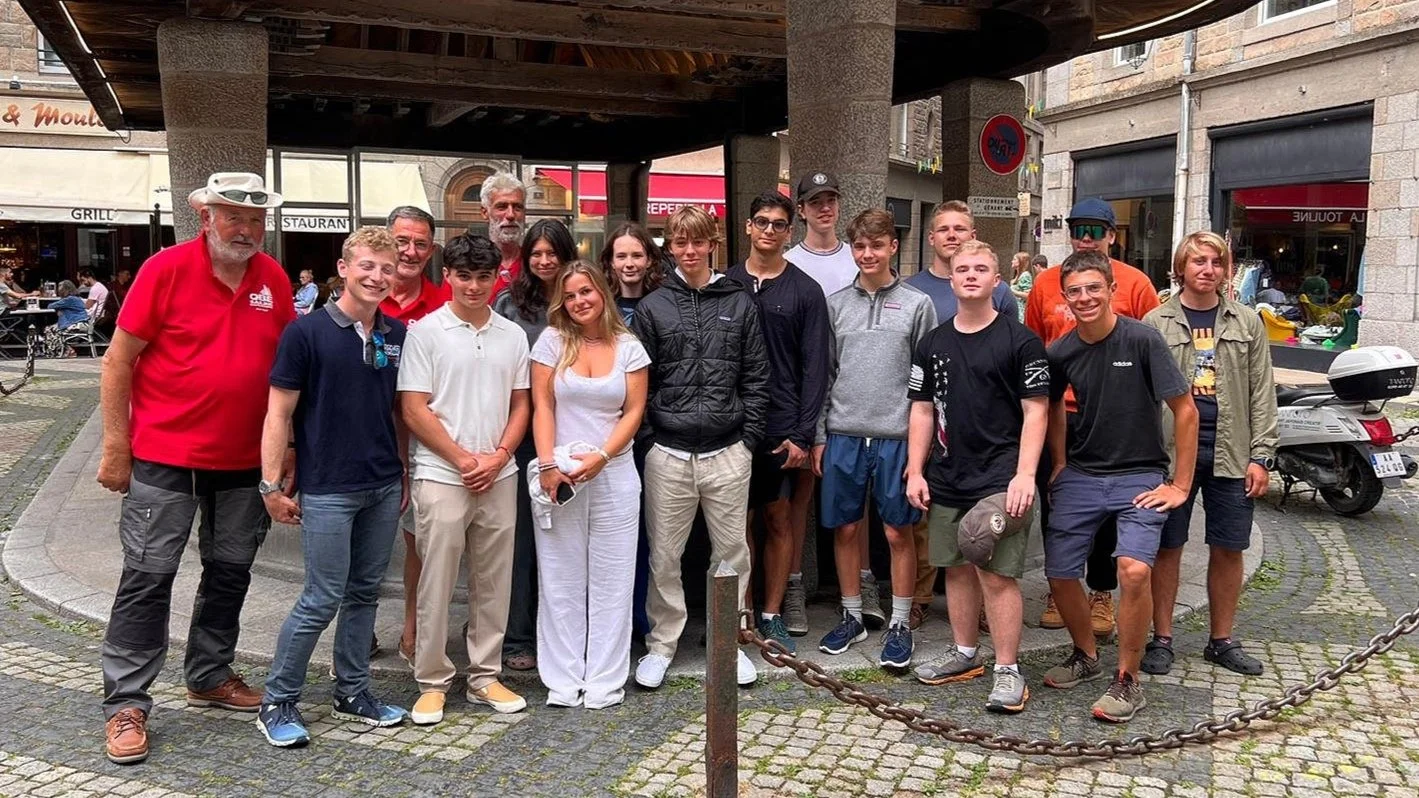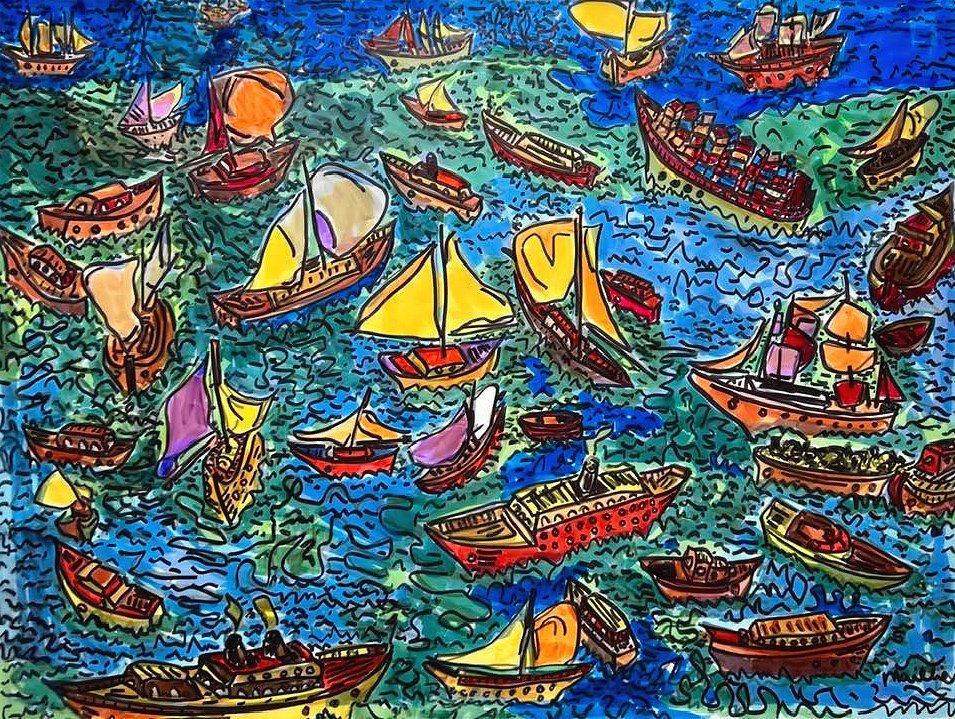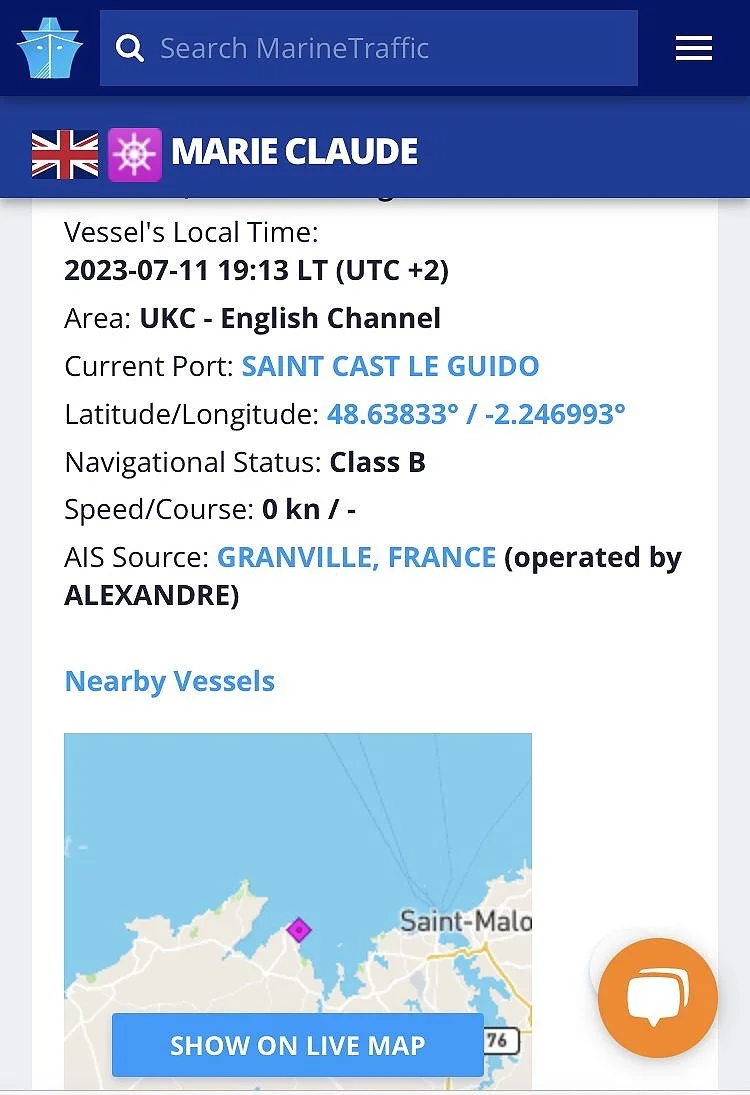Here they are ladies and gentlemen. Please say hello to our July 2023 crew!
Where’s Will (Sutherland)?
(c)Myles Maillie
You can track our progress this season on MarineTraffic.com. Just sign up (it’s free) and type in Marie Claude or Yseult. Voilà !
Read About our sailing expeditions In “The Good Life France”
Check out the article about QBE sailing expeditions in the most recent edition of The Good Life France.
Pilot cutters: “the finest sailing boat design ever”
We tell people we take teens on sailing expeditions aboard two classic pilot cutters. And some folks just shrug: “Are we supposed to be impressed?” Well… yes, yes you are. All boats are not created equal. In our last post we featured QBE founder and director Will Sutherland talking about his cutters, built according to a 19th-century French design. But, in fact, our boats are very similar to the famous pilot cutters built to ply the treacherous Bristol Channel, about 200 miles north of Saint-Malo, our home port. Here’s the first part of a documentary by Tom Cunliffe about the history of one of Britain’s most storied boats.
(The first part of the documentary is 16 minutes long.)
“Many consider the Bristol Channel pilot cutter to be the finest sailing boat design ever. Fast, seaworthy and beautiful to behold, the pilot cutter is the perfect combination of form and function - a thoroughbred perfectly adapted to a life in one of the Britain’s most treacherous stretches of water. Sailor and writer Tom Cunliffe explores the life of the pilots and sails a perfectly restored cutter to find out just what drove these men and their wonderful machines.”
”
Expeditionary learning. It works. And here’s the evidence:
This is a tale of two schools: an ocean apart geographically and demographically, but with the same noteworthy co-curricular requirement for every student. One school, St. Benedict’s Prep in Newark, New Jersey (USA), costs US$13,000 (about 11,500€/£9,700) a year to attend, though most students receive financial aid. The campus is surrounded by urban blight. The other school, Aiglon|Switzerland, costs close to ten times that much. It is situated in the idyllic Alpine ski resort of Chesières-Villars, high above the Rhône Valley and nearby Lake Geneva. Interestingly, as dissimilar as the schools are in many respects, both have a common challenge: helping their students build character, resilience, and self-esteem. In that regard, it turns out that kids who come from extremely “advantaged” backgrounds can struggle as much as kids who come from “disadvantaged” backgrounds. (It can be dispiriting, even emotionally debilitating, to grow up in the long shadow of an extremely successful and/or famous parent, trying to find your own identity and path in life, just as it’s hard to overcome the many day-to-day challenges of growing up poor.) To address the character/resilience/self-esteem issue, both schools rely on a time-tested pedagogical strategy to get impressive results: EXPEDITIONS.
Two entirely different schools. yet their Small-group expedition dynamics and results are almost exactly the same.
Your scribe met QBE director Will Sutherland years ago at Aiglon, when it was much less expensive. Will was a mathematics teacher and sports master. I was a student. Challenging outdoor expeditions were one of the pillars of the school’s co-curriculum—and ethos. (The founding headmaster, John Corlette, spent some time at Gordonstoun, in Scotland, with expeditionary-learning advocate and Outward Bound® founder Kurt Hahn. Consequently, “JC” became a believer in the benefits of outdoor adventure early in his teaching career.) As much as anything else, the expedition component of an Aiglon education defined our unique boarding school experience. And apparently it still does. Here’s a recent Aiglon video of a rock climbing sortie:
FYI: A via ferrata (Italian for “iron route/path”) is a climbing route that employs steel cables, rungs, and or ladders, fixed to the rock to which climbers attach harnesses to secure themselves and mitigate the danger of any potential fall. Vie ferrate eliminate the obvious risks of unprotected scrambling and climbing or the need for sophisticated climbing equipment; in other words, they facilitate mountain climbing for beginners.
*QBE is not affiliated with Aiglon|Switzerland and the presence of this video on our blog is in no way an endorsement of QBE Outdoor Education by Aiglon or vice versa. It is intended only to make a point about the profound impact of outdoor adventure on high school students.
Below is another video, a short documentary, about an annual trekking expedition that is required for graduation from St. Benedict’s Prep. Many Newark schools are what Americans call “challenged”; their achievement test scores are embarrassingly low. But St. Benedict’s, an inner-city Catholic school, is a remarkable outlier—it graduates 98% of its students and 85% go on to earn undergraduate degrees! The school believes that a five-day trek every first-year high-school student is required to join is a large contributor, if not THE key, to its remarkable academic results.
“It is probably THE most important thing we do…above and beyond the academics…. Every school in the country should find some way to get their kids out in nature to realize there’s something bigger than you.”
—Ivan Lamourt, St. Benedict’s Director of Counseling
The school’s regular expedition route is a 55-mile stretch of the Appalachian Trail, the famous woodland path that stretches across 14 states, from Maine to Georgia, through the ridges and valleys of the Appalachian Mountains. The school has been such an amazing success story that it and its Trail expedition were featured on the popular U.S. television news magazine “60 Minutes.” (QBE did its first post about St. Benedict’s a few years ago.)
What is striking are the comments of students from both Aiglon and St. Benedict’s; they are all on the same page. They come away from their outdoor adventures with similar revelations. They learn the same life lessons. And those lessons stick.
*QBE is not affiliated with St. Benedict’s Prep and the presence of this video on our blog is in no way an endorsement of QBE Outdoor Education by St. Benedict’s or vice versa. It is intended only to make a point about the profound impact of outdoor adventure on high school students.
So there you have it: the magic that happens when you undertake a strenuous exploit, outside your comfort zone, to achieve an ambitious goal.
Sailing expeditions are a variation on the trekking/mountaineering theme, just in a different register (You’re on the water, not land; and you use your arms and hands more than your legs). Participants learn teamwork, resilience, and leadership along with sailing skills and something about our area’s local cultures and history. They form strong bonds with new friends—their fellow crew members. And, like other young expeditioners, many of them come away with experiences and new insights they can use to help craft winning university admission essays.
Service projects are laudable and enormously satisfying moral imperatives. Challenging small-group expeditions, organized and supervised in large part by the participants themselves, are a different breed of endeavor—consequential investments in motivation, character, and confidence that also pay surprisingly high academic dividends. Who would have thought? Testing your limits outdoors usually translates into higher academic achievement in the classroom. It seems a stretch. But there’s ample evidence it’s true. Ambitious expeditions can be life-changers in many different ways, and we enthusiastically commend them to parents and teens looking for transformative summer enrichment.
The difference quality instruction can make
You never know what you’ll find when you scroll through a Twitter feed. Recently, your scribe stumbled across a 2008 article in The New Yorker written by public intellectual Malcolm Gladwell; the title of his piece was MOST LIKELY TO SUCCEED, How do we hire when we don’t know who’s right for the job? He proceeds to compare great American football quarterbacks to school teachers. (For those of you not familiar with American football, the quarterback is the player who distributes the football to other players on a team’s offensive unit, i.e., he’s the key offensive player. Good quarterbacks are the sine qua nons of championship-caliber teams.) In his article, Gladwell uses anecdotes to illustrate how hard it is for scouts to divine who will develop into a great professional quarterback and who won’t. (Most great university quarterbacks wind up being disappointments when they turn pro.)
Then he moves on to teachers. Just like quarterbacks, they are absolutely essential for [educational] success and apparently just as difficult to assess when freshly minted. You have to see them in action over time to see if you have a winner.
“One of the most important tools in contemporary educational research,” Gladwell writes, “is ‘value added’ analysis. It uses standardized test scores to look at how much the academic performance of students in a given teacher’s classroom changes between the beginning and the end of the school year…. [A change in] the students’ rankings [expressed as a percentile on math and reading tests] , value-added theory says, is a meaningful indicator of how much more effective [one teacher is than another].”
He then goes on to write,
“…the difference between good teachers and poor teachers turns out to be vast.
Eric Hanushek, an economist at Stanford, estimates that the students of a very bad teacher will learn, on average, half a year’s worth of material in one school year. The students in the class of a very good teacher will learn a year and a half’s worth of material. That difference amounts to a year’s worth of learning in a single year. Teacher effects dwarf school effects: your child is actually better off in a ‘bad’ school with an excellent teacher than in an excellent school with a bad teacher. Teacher effects are also much stronger than class-size effects. You’d have to cut the average class almost in half to get the same boost that you’d get if you switched from an average teacher to a teacher in the eighty-fifth percentile. And remember that a good teacher costs as much as an average one, whereas halving class size would require that you build twice as many classrooms and hire twice as many teachers.
Hanushek recently did a back-of-the-envelope calculation about what even a rudimentary focus on teacher quality could mean for the United States. If you rank the countries of the world in terms of the academic performance of their schoolchildren, the U.S. is just below average, half a standard deviation below a clump of relatively high-performing countries like Canada and Belgium. According to Hanushek, the U.S. could close that gap simply by replacing the bottom six per cent to ten per cent of public-school teachers with teachers of average quality. After years of worrying about issues like school funding levels, class size, and curriculum design, many reformers have come to the conclusion that nothing matters more than finding people with the potential to be great teachers. But there’s a hitch: no one knows what a person with the potential to be a great teacher looks like. The school system has a quarterback problem.”
QBE doesn’t have a quarterback problem. In fact, our “quarterback” is probably our greatest asset. We have truly fabulous boats. We go to amazing places. We have all the assets anyone could want to provide an exceptional expeditionary education experience. Of course, other programs have some great assets, too. But what precious few have is a gifted quarterback like ours. Teaching is as much—if not more—an art than a science. Once again, Gladwell:
“A group of researchers—Thomas J. Kane, an economist at Harvard’s school of education; Douglas Staiger, an economist at Dartmouth; and Robert Gordon, a policy analyst at the Center for American Progress—have investigated whether it helps to have a teacher who has earned a teaching certification or a master’s degree. Both are expensive, time-consuming credentials that almost every district expects teachers to acquire; neither makes a difference in the classroom. Test scores, graduate degrees, and certifications—as much as they appear related to teaching prowess—turn out to be about as useful in predicting success as having a[n aspiring professional] quarterback throw footballs into a bunch of garbage cans.”
Will Sutherland has been teaching outdoor and life skills (as well as mathematics) his entire life. One of his former students once told your scribe he was the best teacher she ever had. Here’s another believer:
“…under Will’s impeccable guidance and mentorship, we felt safe yet consistently challenged as we learned the many important skills needed to sail a boat and compete effectively in a large race [Cowes Week]. My best memories of the experience were bonding with my fellow boat mates as we pursued a common goal and learned to work together and communicate effectively under pressure and in a highly compressed period of time. Will is a tremendous organizer and inspiring leader who is highly adept at facilitating this type of endeavor. I would wholeheartedly and enthusiastically recommend any program that he is involved with….and would sign up in a heartbeat if I were 18 again!”
—Dariane H., Concord, MA, USA
Many of us can point to one or two teachers we had in school who made a profound impact on us. Will is that kind of difference maker. And (along with the opportunity to go sailing on his jaw-dropping pilot cutters) he’s the reason many of us volunteer our time to help out with the project. When it comes to teaching gaff-rig sailing and mentoring youngsters, he’s proven over time that he’s the real deal—an all-pro quarterback. You can read a short bio HERE.
World-Class Mentoring
Here's a question: What do several Hollywood movie stars and directors, a Formula One racing champion, numerous high-profile CEOs, ambassadors, and even a few members of the world's royal families have in common? Answer: They all have children who once were coached, taught, or mentored by ELS director Will Sutherland.
Spoiler Alert
It so happens that every August there is a regatta in St-Malo. People show up from all over the place to race their boats and party. Well, as it turns out, several August ELS crew members (along with some staff) participated. We're still waiting on some pics from the organizers to make a splash, but... it turns out that our two boats came in first and second in their class. One larger boat came in first in the traditional boats race, but because of its size and sail dimensions, it technically falls within a different category. So there it is. Can Will Sutherland teach sailing or what?
As soon as we get the pics, we'll post 'em. In the mean time, congratulations to our August crews!
—So Jane, what did you do this summer?
—Well, I did a little sailing in France and the English Channel and won a regatta in St-Malo. You?
X Marks The Spot
"Here's the deal: I'll get us to this little island right... here. Then you have to figure out how to get us back home."
The "Nearest Remoteness" You Can Find!
In all my years sailing around the North and South Atlantic, the Mediterranean and the English Channel, I have found no better cruising waters than the Brittany Coast and the Channel Islands. The breathtaking beauty of the rugged coastlines, the numerous nooks, crannies, inlets and rivers to explore, and the hundreds of small islands that rise out of the sea collectively create a wonderful wilderness. And yet civilisation is never far away.
Saint-Malo with its old city walls, St Helier with its fine wines and fruit and vegetable market, St Peter Port with its seafood restaurants and craft beer are favourite ports of call.
When you add into the mix the charm of historic village lifestyles and the sandy beaches of the nearby islands of Herm, Sark and Alderney, you have a holiday paradise. The stress of modern life melts away as you sail from island to island with dolphins and seabirds for company.
Across the Channel, only a day’s sail away, lies the south of England. Of course, Dartmouth, Plymouth and Falmouth on the South Devon and Cornwall coasts are all worth a visit. But I particularly like the small fishing ports that dot the coastline: Salcombe, Looe, Polperro, Fowey and Mevagissey, to name but a few.
—Will Sutherland









